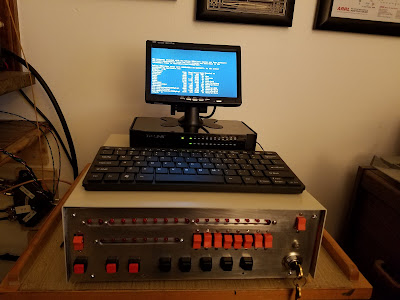Hardware updates on my Mini-Computer (updated 9/2016)
More on my Mini-computer
I added some hardware. Here's why.
When you have multiple processors, you need to have communications between them. In this case, when I want to start the pdp-11 program I ssh to the processor it runs on (pi5) and start the application. After that I telnet from a different box (thru the ethernet switch) to connect and do whatever.
Question: what happens if the ssh connection goes away? For example, I need to reboot the computer the ssh session was started on. Well, then the pdp-11 application dies and corrupts the pdp-11 hard disk. Bad ju-ju.
So. What I need is a dedicated console attached just for enabling the pdp computers (pdp-11, pdp-8). How best to do that?
I could use a serial console. I got rid of my ADM-31 some time ago and the last time I had a Soroc IQ120 to use was in 1981. They are getting hard to find. Also they are kinda big.
What I did is hook up a small car video display used for car entertainment/back-up cameras. This connects to the 4 pin jack on the processor board. I also found a small keyboard that was usb and would plug into the pi5 usb port.
Works fine. But - I didn't have any connections on the back of the case and had the cables just draped over the top of the back panel. Ugly. Ugly is bad.
The PDP-8 (as most larger computers) have bus connectors on the back allowing peripherals (hard drives, printers, etc) to be connected. My original intent was to have all I/O go thru pi1 (the primary computer). Thinking about that made me realize that I could get better throughput by bringing out a bus for each processor board. Not only that, but having 22 terminals of ethernet traffic going thru one computer makes a bottleneck that I didn't really want.
So I removed the back panel and milled some holes for 4 usb lines and 2 ethernet ports. What I have now is 4 usb ports for the primary computer (pi1) and a usb socket for each of the other processors. I also brought out the ethernet from pi5 (the processor containing the pdp simulators) to it's own port and brought out the 5 port ethernet switch to it's own port. Both of these go to the 24 port ethernet switch seen above.
This gives me a direct connection to the pdp computers without adding traffic to the internal ethernet switch but still giving me access via the external switch.
However - this will slow down the communications when the computer is used as a cluster since one of the processor nodes (and it's 4 cores) goes thru 2 ethernet switches. How much slower?
I re-ran some of the benchmark tests I ran initially. The original configuration used 19 cores and ran in 2.2 seconds. With the new configuration the time increased to 3.5 seconds. So I lost a little in going thru 2 switches, but not as much as I expected. The time went up to a little over 10 seconds by not using the 4 cores from pi5. Having the extra 4 cores available definately made a useable difference.
In addition, having a usb bus brought out for each processor gives me a lot of flexibility in adding peripherals later on. I ended up destroying the back label when I added the ports, so I'll need to make a new one.
I added labels until I make the new back escutcheon. I also took out the db-9's as I'm re-wiring with some cat-5 instead of the smaller wire I used. These are the I/O ports using GPIO and I2C from the processors that connect to some relays and other real-world devices. They'll be back in in a few days.
There's not a lot of wiring yet. This is what I expect the back of the computer to look like when it's complete:
9/2016 - See my updates on the user interface. I'm re-doing the outside interfacing and overall design to meet my goals of a single, powerful box to run a small office (up to 80 users) or a school computer lab. Parts are ordered and I'll post new pictures & block diagrams as I make changes. These changes are making the overall design simpler and give me better performance. I'm also taking away some things I just don't need, even though I think they're useful. The end result will be a true minicomputer, and not something that does everything I may want over 10 years time. This is something that can be thrown in a closet and left for a decade while serving the needs of a small to mid-sized business or school computer lab.
~--~



Comments
Post a Comment